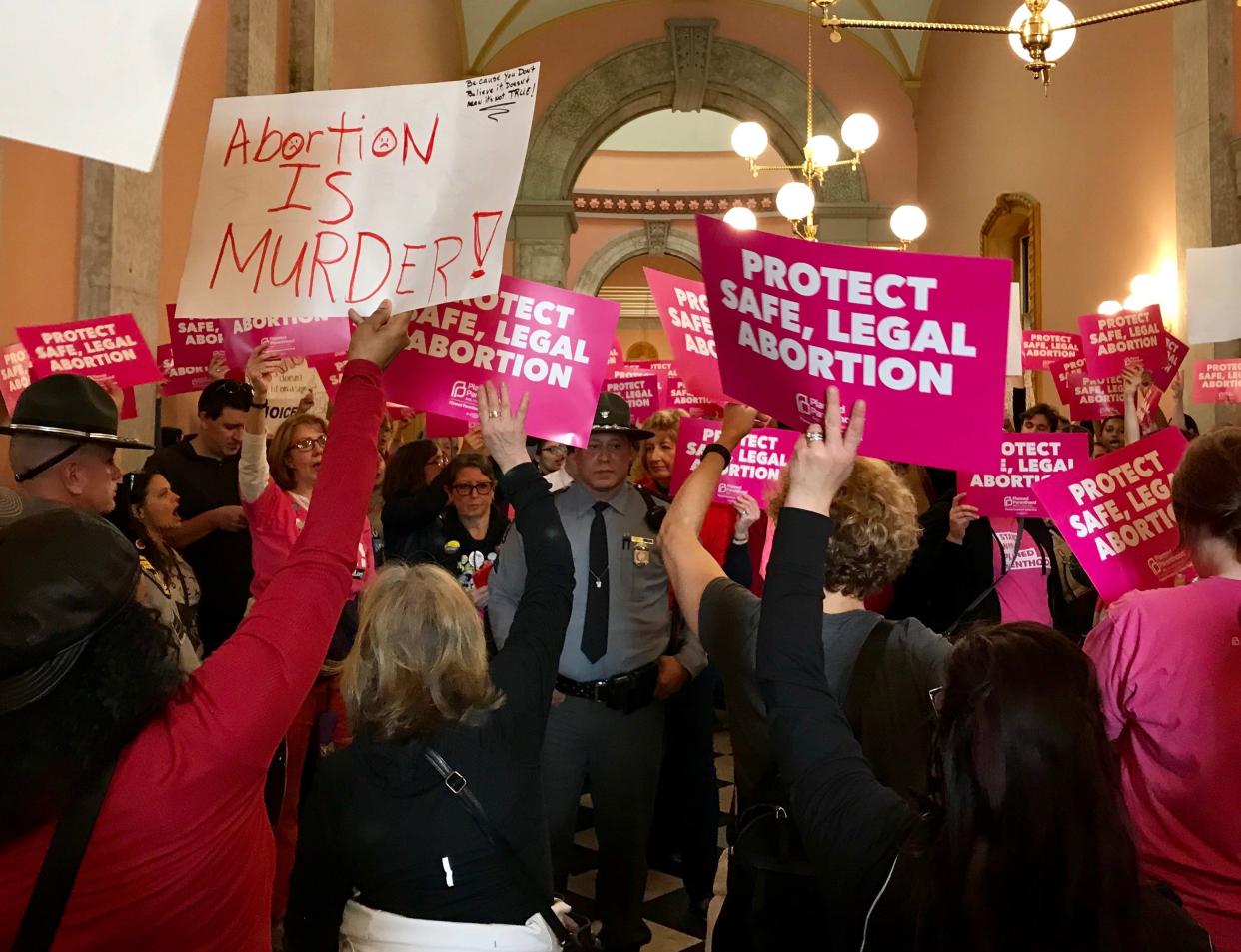Election 2023: What to know about Ohio Issue 1 on abortion, contraception

On Nov. 7, Ohioans will vote on abortion, contraception and other reproductive decisions.
The proposed amendment, called Issue 1 on the ballot, would enshrine the right to an abortion in the state constitution up until viability, which is the point when a fetus can survive outside the uterus with reasonable measures. This is typically around 24 weeks gestation. Doctors could perform abortions after that point to save a pregnant patient's life or health.
The measure would also expressly state that there's a right to access contraception, miscarriage care, fertility treatment and continuing a pregnancy.
The vote comes more than a year after the U.S. Supreme Court overturned Roe v. Wade, sending decisions about abortion policy back to the states. That same day, a law banning most abortions in Ohio took effect.
That 2019 law, called the "heartbeat bill" by its supporters, banned doctors from performing abortions after embryonic cardiac activity was detected, which is about six weeks gestation. While the law had exceptions for life-threatening health conditions, many doctors were confused about when and how that would apply.

That law is currently on hold because of a court order. The Ohio Supreme Court is reviewing that case and could make a decision as soon as later this year.
In response to that law and other abortion restrictions, reproductive rights proponents are asking voters to approve a constitutional amendment on Nov. 7 that allows doctors to decide when pregnant patients obtain abortions in Ohio. Opponents say the language is too broad and will lead to a slew of dangerous consequences.
Readers submitted questions about this proposed amendment. Here are some responses to help you understand the issue.
If Ohio Issue 1 passes, what language would be added to the Ohio Constitution?
A. Every individual has a right to make and carry out one’s own reproductive decisions, including but not limited to decisions on:
contraception;
fertility treatment;
continuing one’s own pregnancy;
miscarriage care;
and abortion.
B. The State shall not, directly or indirectly, burden, penalize, prohibit, interfere with, or discriminate against either:
An individual’s voluntary exercise of this right or
A person or entity that assists an individual exercising this right, unless the State demonstrates that it is using the least restrictive means to advance the individual’s health in accordance with widely accepted and evidence-based standards of care.
However, abortion may be prohibited after fetal viability. But in no case may such an abortion be prohibited if in the professional judgment of the pregnant patient’s treating physician it is necessary to protect the pregnant patient’s life or health.
C. As used in this Section:
“Fetal viability” means “the point in a pregnancy when, in the professional judgment of the pregnant patient’s treating physician, the fetus has a significant likelihood of survival outside the uterus with reasonable measures. This is determined on a case-by-case basis.”
“State” includes any governmental entity and any political subdivision.
D. This Section is self-executing.

How many abortions occur in Ohio? How many are performed after viability?
The Ohio Department of Health tracks how many abortions occur in Ohio and compiles that data in an annual report. The most recent report is from 2021 when 21,813 abortions were performed in Ohio, including 20,716 (or 95%) abortions obtained by Ohio residents.
Most abortions that year, 87.5%, occurred at 12 weeks gestation or earlier. Only 0.7% occurred after 21 weeks gestation; the state does not detail the specific week of the abortion beyond that general category.
The Ohio Department of Health's 2022 report will be released before Oct. 1 and will offer insight into what happened after the U.S. Supreme Court overturned Roe v. Wade in June 2022 and Ohio's ban on most abortions took effect.
#WeCount, a national reporting effort sponsored by the Society of Family Planning, has more up-to-date numbers. It found that Ohio dropped from more than 2,000 abortions performed in April 2022 to 800 in July and 770 in August as a result of the state's abortion restrictions.
Didn't we just vote on Ohio Issue 1?
The proposed amendment on reproductive decisions is Issue 1 on the Nov. 7 ballot.
That might be a little confusing because Ohioans just voted on an Issue 1 in August that, if passed, would have raised the threshold needed to amend the state constitution. Voters rejected that proposal, 57% to 43%.
But each election, the ballot issues are assigned numbers starting with one and that means there are dozens of Ohio Issue 1s from past years.
Ohio Issue 2 on the Nov. 7 ballot is about legalizing recreational marijuana.
Why can politicians write new ballot language?
Ohio has a process for citizens to put issues on the ballot.
One of the steps involves the Ohio Ballot Board, a five-member panel that writes the ballot language voters will read at the polls. This language does not need to match the language proponents used on petitions circulated to get the measure on the ballot.
If the measure is approved, the full amendment's language − not the ballot language − will appear in the Ohio Constitution.
The current Ohio Ballot Board is composed of three Republicans, including Ohio Secretary of State Frank LaRose, and two Democrats. The partisan balance of the board depends on who wins the Ohio Secretary of State's race.
Does the Ohio Issue 1 leave the possibility of an abortion up to the moment of birth?
The proposed constitutional amendment allows doctors to perform abortions after viability (around 24 weeks gestation) "to protect the pregnant patient’s life or health."
Opponents of the measure say this language gives physicians wide latitude to perform abortions late into pregnancy while stripping state lawmakers and courts of the ability to stop them.
"By failing to explicitly define viability, and by giving abortionists the final word in determining when a child is viable on a case-by-case basis, Issue 1 leaves the door wide open for painful, late-term abortions," said Amy Natoce, spokeswoman for Protect Women Ohio, which opposes the amendment.
Proponents of the amendment say doctors will only be able to perform abortions if the patient's life or health is at risk. They add that doctors and patients should make that decision, not lawmakers.
"People need abortions at different points in pregnancy," executive director of Pro-Choice Ohio Kellie Copeland said. "We think that it is critically important that there not be a law on the books that prevents people from getting live-saving care, that forces people to continue what could be a doomed pregnancy against their will, against medical advice."
How does Ohio Issue 1 compare to abortion access under Roe v. Wade?
Both Ohio's proposed constitutional amendment and the U.S. Supreme Court decision in Roe v. Wade use "viability" as the line between when abortion is legal and when it can be restricted. Viability is when a fetus can survive outside the uterus − which is about 24 weeks gestation.
Because fetal development and access to healthcare vary, viability isn't a completely fixed mark. Survival rates can differ dramatically depending on when delivery occurs and the quality of treatment available.
For example, survival ranged from about 30% at 22 weeks gestation with active treatment at birth to 71.4% at 24 weeks gestation with active treatment, according to a 2022 report on extremely preterm babies born at 19 U.S. academic centers between 2013 and 2018.
The report found that 21.2% of extremely preterm babies had severe neurodevelopmental impairment at their 2-year checkup; 48.7% had no or mild impairment.
Like in Roe, the ballot measure would allow abortions later in pregnancy to save the mother's life or health.
Ohio Issue 1 uses the term "individual" instead of "woman." Does that mean a minor has a right to an abortion without their parent's consent?
The measure uses the term "individual" or "pregnant patient" instead of "woman." Abortion opponents argue that language gives minors the same rights to make reproductive decisions as adults, eliminating limits like parental approval to have an abortion.
"This is very deliberate the way the amendment is written. It's very open-ended so it includes everyone," said Columbus-area attorney Mehek Cooke, who opposes the amendment.
Copeland explains the word choice: "(The word individual), It includes nonbinary people. It includes trans people. There are lots of individuals who may need abortion care, and I think just legally and technically that is the more appropriate word."
If Issue 1 passes, judges would be tasked with deciding whether abortion limits, ranging from bans and a mandatory 24-hour waiting period to parental consent, violate the new language in the state constitution.
Attorneys offer vastly different opinions on how that would go. Dan Kobil, a professor of constitutional law at Capital University, said the amendment would have "zero effect on parental consent." Meanwhile, Frank Scaturro, senior counsel at the conservative Judicial Crisis Network, said: "This Ohio proposal would out-of-hand eliminate the possibility of any parental involvement at all."
More: What would an Ohio abortion amendment mean for parental consent?
Jessie Balmert is a reporter for the USA TODAY Network Ohio Bureau, which serves the Columbus Dispatch, Cincinnati Enquirer, Akron Beacon Journal and 18 other affiliated news organizations across Ohio.
Get more political analysis by listening to the Ohio Politics Explained podcast
This article originally appeared on Cincinnati Enquirer: Issue 1 Ohio abortion ballot measure facts, language, what yes, no means

